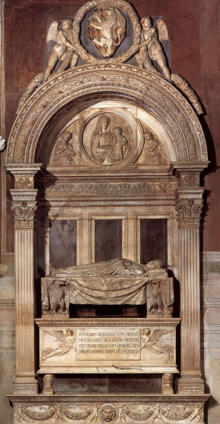Bernardo Rossellino
Bernardo Rossellino , actually Bernardo di Matteo Gamberelli (* 1409 in Settignano , † 1464 in Florence ) was an Italian sculptor and builder ; who learned and also worked at LB Alberti. His eldest brother was the Italian painter Antonio Rossellino (1427–79), whose father was the sculptor Matteo di Domenico del Borra.
Live and act
The Florentine architect worked in Arezzo from 1433 to 1435 for the brotherhood of the Laici, for whom he built a monastery. From December 1, 1451, he was involved in the construction of St. Peter's Basilica under Pope Nicholas V as an “engineer of the palace” and also designed the Palazzo Venezia .
His main place of work, however, was Florence, where from 1461 he carried out building projects and decoration work as a cathedral builder. His most important sculptural work is the tomb of Leonardo Bruni in the church of Santa Croce (1444-50), whose conception as a wall niche grave for other artists until the end of the 15th century became a model for grave monuments. Here, basic architectural forms are combined with sculptural elements in a special and new way. The filling of the lunette (arched field with depiction of the Madonna), the tondo (half-relief in a circle) flanked by angels and the antique columns set up on both sides are a recurring basic scheme in the structure of the tomb.
As an architect , he initially continued Leon Battista Alberti's project for the Palazzo Rucellai (1446–51), whose inner courtyard he designed. In today's Pienza , a rural town south of Siena, he planned and built the conversion of the medieval city, which was then still called Corsignano , for the birthplace of the humanist Enea Silvio Piccolomini and later Pope Pius II (1458–64) . In the form of a modern city layout, this should take up the urban planning ideals of the time and correspond more closely to the new ideas of a well-ordered and ideal community. The square plays an important role as a central point for encounters and trade.
The builder also counts the main church of Pienza (S. Maria Assunta) among his building projects, which externally shows Alberti's facade scheme and inside was committed to the concept of hall churches . The Palazzo Piccolomini , built for the Pope after 1459, shows similarities with the Palazzo Rucellai in Florence and comes from his hand as well as the Palazzo Publico in Pienza.
literature
- Anne Markham Schulz: The Sculpture of Bernardo Rossellino and His Workshop. Princeton 1975
- Andreas Tönnesmann : Pienza - urban development and humanism. Verlag Klaus Wagenbach, Berlin, 2013, ISBN 978-3-8031-2717-4 .
- Andreas Tönnesmann: Praise of the building costs , in: The freedom of viewing. Writings on architecture, art and literature . gta Verlag, Zurich 2013, ISBN 978-3-85676-323-7 .
- Giorgio Vasari : The life of Giuliano da Maiano, Antonio and Bernardo Rossellino, Desiderio da Settignano and Benedetto da Maiano. Newly translated into German by Victoria Lorini. Ed., Commented by introduced by Sabine Feser and Christina Irlenbusch. Verlag Klaus Wagenbach , Berlin 2012, ISBN 978-3-8031-5057-8 .
Web links
- Bernardo Rossellino. In: arch INFORM . (Biography)
- Biography (italian)
Individual evidence
- ^ Andreas Tönnesmann: Pienza . Urban planning and humanism. Klaus Wagenbach, Berlin 2013.
| personal data | |
|---|---|
| SURNAME | Rossellino, Bernardo |
| ALTERNATIVE NAMES | Bernardo di Matteo Gamberelli; Rossellino del Proconsolo |
| BRIEF DESCRIPTION | Italian sculptor and builder |
| DATE OF BIRTH | 1409 |
| PLACE OF BIRTH | Settignano |
| DATE OF DEATH | 1464 |
| Place of death | Florence |
